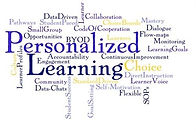Lindsay Achtman
Teacher. Leader. Lifelong Learner
My Future Begins Again
For the last 26 years of my life, the future seemed set. I would work hard in school, get into a great college, pursue a degree in education, and get a job as a teacher. Even the prospects of obtaining my Master’s of the Arts did not require any planning as it is a pertinent step towards earning my Professional Certificate. Now here I stand at the end of my MAET program and for the first time my future is open to a million different possibilities that I have not needed to think about until this very moment. It is an endeavor that I do not take lightly. I have become empowered with knowledge of technology and its benefits for education, now it is my responsibility to create goals that will allow me to successfully implement it in order to benefit my Second Graders. For this to be achieved, my learning journey must continue. Three main goals that I will be focusing on are using technology to personalize student learning, integrating Project-Based Learning with my current units of study, and how to pursue grants in order to fund these classroom projects.
My first goal is to use technology to personalize student learning. Students come to us with different needs. As teachers, it is our duty to tap into their strengths and allow them to grow. In my own classroom alone, I have students working on all different word lists from kindergarten words all the way to third grade words. I am exhausted from trying to create varieties of worksheets and scheduling groups in each subject area just to meet all of the individual needs. Luckily, my school this year has installed five desktop computers into my classroom. Twitter will be a useful resource in becoming educated on the different ways other teachers are using technology to personalize learning. By searching “personalized learning” I am able to watch youtube videos, read research articles, and become engaged in conversation with technology leaders across the world. There are also numerous websites I will take the time to explore recommended to me by my colleagues designed to differentiate concepts connected to the Common Core Standards. Websites like kidsa-z.com, spellingcity.com, khanacademy.org, and prodigygame.com are possibilities.
My second goal is to research how I can implement Project Based Learning in my own classroom. I will begin by reading “Setting the Standard for Project Based Learning” by John Larmer, John Mergendoller, and Suzie Boss. This is an important first step because I have only researched the basic definitions and benefits of Project Based Learning. If I am going to implement it I will require a strong foundation on how to introduce it into my current curriculum. Next, I will need to explore BIE.org and Edutopia.org to get ideas of other projects that have been done before. I will also need to compare the ISTE Standards and see how they could align with the Common Core State Standards I use everyday. Once a project has been chosen and I am familiar with the steps to implement, I can begin to do so as a trial run in my classroom. I do not expect for my first try to be perfect, but with practice I hope to create higher level thinking experiences my students will enjoy and learn from together. Eventually, I hope to gain the confidence to come up with my own project ideas to
share with my colleagues.
My third goal is to learn more about how to pursue and write grants in order to implement Project Based Learning and other technology driven activities. Understanding the benefits of these learning experiences is useless if you do not have the funding or means to pursue them. I began to dabble with writing grants through one of my MAET courses but still feel lost. Many grants come with a time constraint and only choose a few participants. Once a participant has been chosen, they follow up closely to see how their money went to good use. While I understand the grant process, I am confused about where to find grants to apply for. Once I find a grant to apply for, I am not sure how to write a strong but concise grant. The book, “Proposal Writing: Effective Granstmanship” by Soraya M. Coley and Cynthia A. Scheinberg, offers a step by step guide on how to find and write grant proposals. It also focuses on how to develop a viable project, evaluate outcomes, and how to prepare an application for funding. I will also Google Search, “Grants for Teachers” in order to begin finding grant opportunities.




